Did you know that bok choy, also known as Chinese white cabbage, can be stored in the refrigerator for 3 to 5 days? This leafy green vegetable is not only delicious but also packed with nutrients, making it a healthy addition to your meals. Whether you’re a fan of stir-frying, sautéing, roasting, or braising, bok choy offers endless possibilities in the kitchen.
Key Takeaways:
- Cooking bok choy is a flavorful and healthy way to enhance your meals.
- When selecting bok choy, look for bright green leaves with firm off-white stalks.
- Before cooking, wash and dry the leaves and stems, and cut them into smaller pieces.
- Stir-frying and sautéing are preferred methods for cooking bok choy, as they bring out the best texture and flavor.
- Explore different recipes and get creative with bok choy in your cooking.
How to Cook Bok Choy: A Step-by-Step Guide
Cooking bok choy is a delicious way to enjoy this versatile vegetable. Whether you’re a beginner in the kitchen or an experienced cook, here’s a step-by-step guide to help you prepare bok choy with ease.
1. Rinse and Dry: Start by rinsing the bok choy under cold water to remove any dirt or debris. Pat it dry using a clean kitchen towel or paper towels.
2. Cutting: If you have larger bok choy, cut away the leafy green sections and separate the stalks. Cut the stalks into small, bite-sized pieces. For baby bok choy, you can leave them whole or cut them into smaller portions.
3. Cooking Methods: Bok choy can be cooked using various methods such as steaming, braising, simmering, stir-frying, or sautéing. However, for the best texture and flavor, stir-frying and sautéing are preferred.
“Stir-frying and sautéing are excellent methods for cooking bok choy. These techniques bring out the natural sweetness of the vegetable while retaining its crispy texture.”
4. Stir-Frying Bok Choy: To stir-fry bok choy, cut the vegetable in half lengthwise. Heat some oil in a pan or wok over medium-high heat and add the cut bok choy. Cook it for a few minutes until the edges are golden brown. You can also add aromatics like minced garlic and ginger for extra flavor.
Benefits of Stir-Frying Bok Choy
Stir-frying bok choy not only enhances its taste but also retains its nutritional value. The quick cooking process preserves the nutrients, making it a healthy and flavorful choice.
5. Sautéing Bok Choy: Sautéing bok choy is another simple and tasty method. Heat some oil in a skillet or pan over medium heat. Add the bok choy and cook for a few minutes until it begins to wilt. You can season it with salt, pepper, or a splash of soy sauce for added flavor.
6. Experiment with Flavors: Bok choy pairs well with a variety of flavors. Feel free to add other ingredients like soy sauce, oyster sauce, sesame oil, chili flakes, or your favorite seasonings to enhance the taste according to your preference.
7. Serve and Enjoy: Once your bok choy is cooked to perfection, serve it as a side dish, add it to stir fry, or incorporate it into your favorite recipes. Bok choy’s mild and slightly sweet flavor makes it a versatile ingredient that complements various dishes.
| Method | Taste | Texture | Preparation Time | Difficulty Level |
|---|---|---|---|---|
| Stir-Frying | Light and Crispy | Crunchy Stalks, Tender Leaves | Quick | Easier |
| Sautéing | Mild and Tender | Soft and Wilted | Quick | Easier |
| Steaming | Mild and Tender | Soft and Moist | Short | Easy |
| Braising | Rich and Savory | Meltingly Soft | Long | Moderate |
Sautéed Bok Choy Recipe: Quick and Delicious
Sautéed bok choy is a quick and delicious way to cook this green vegetable. With its vibrant colors and flavors, this sautéed bok choy recipe will surely become a favorite in your kitchen. Here’s what you’ll need:
- Baby bok choy
- Soy sauce
- Vegetable broth
- Rice vinegar
- Sesame oil
- Honey
- Red chili flakes
- Vegetable oil
- Minced garlic
- Minced ginger
- Green onions
- Sesame seeds
To begin, rinse and dry the bok choy, then cut it in half. In a small bowl, combine soy sauce, vegetable broth, rice vinegar, sesame oil, honey, and red chili flakes to create a flavorful sauce.
Now it’s time to sauté! Heat vegetable oil in a skillet over medium-high heat. Add the bok choy cut side down and cook until browned, which usually takes about 2 minutes. Then, flip the bok choy and add minced garlic, minced ginger, and green onions for an extra burst of flavor.
Pour the sauce mixture over the bok choy and continue to cook until the sauce has glazed the vegetables, which typically takes another 2-3 minutes. Keep an eye on the skillet to prevent overcooking the bok choy.
And voila! Your sautéed bok choy is ready to be enjoyed. Garnish it with sesame seeds for an added touch of crunch and visual appeal.
This sautéed bok choy recipe makes for a perfect side dish to complement any meal. Its combination of flavors and textures will leave your taste buds satisfied and your dinner guests impressed.
Sautéed Bok Choy Recipe Ingredients
| Ingredients | Quantity |
|---|---|
| Baby bok choy | 2 heads |
| Soy sauce | 2 tablespoons |
| Vegetable broth | 1/4 cup |
| Rice vinegar | 1 tablespoon |
| Sesame oil | 1 teaspoon |
| Honey | 1 teaspoon |
| Red chili flakes | 1/4 teaspoon |
| Vegetable oil | 2 tablespoons |
| Minced garlic | 2 cloves |
| Minced ginger | 1 tablespoon |
| Green onions | 2 stalks |
| Sesame seeds | 1 tablespoon |
Roasted Bok Choy: A Flavorful Twist
Roasting bok choy is a simple yet delicious way to bring out its unique flavors. The combination of tender greens and slightly charred edges creates a delightful contrast that will surely tantalize your taste buds. Here’s how you can roast bok choy to perfection:
- Preheat your oven to 425°F (220°C).
- Rinse the bok choy thoroughly under cold water to remove any dirt or debris. Pat it dry with a clean kitchen towel.
- Cut the bok choy lengthwise into halves or quarters, depending on the size of the leaves.
- Place the bok choy on a baking sheet, cut side up.
- Drizzle the bok choy with olive oil, making sure to coat all the leaves and stalks.
- Season with salt and pepper, or any other desired herbs and spices.
Now, it’s time to let the oven work its magic. Roast the bok choy for about 12-15 minutes, or until the leaves have wilted and the edges are slightly charred. Keep an eye on it to prevent overcooking.
Once roasted, the bok choy can be enjoyed as a delicious side dish or used in various recipes. Its smoky flavor and tender texture make it a versatile addition to stir-fries, salads, or even as a topping for pizzas or sandwiches. Let your culinary creativity shine!
Health Benefits of Roasted Bok Choy
Roasted bok choy not only offers great taste but also packs a powerful nutritional punch. It is low in calories and rich in essential vitamins and minerals like vitamin C, vitamin K, and calcium. The high fiber content promotes healthy digestion while the antioxidants help support overall well-being. So, by enjoying this flavorful twist on bok choy, you’re not only treating your taste buds but also nourishing your body.
Stir-Fried Bok Choy: Quick and Easy
Stir-frying is a quick and easy method to cook bok choy and create a flavorful dish. By following a simple recipe, you can enjoy the vibrant colors and crispy texture of this nutritious vegetable. Let’s get started!
For a delicious stir-fried bok choy, gather the following ingredients:
- Baby bok choy
- Vegetable oil
- Garlic
- Ginger
- Soy sauce
- Chicken broth
- Cornstarch
Start by rinsing and drying the bok choy, then cut it into halves. The halves will cook evenly and retain their crispness.
In a wok or skillet, heat some vegetable oil. Add minced garlic and grated ginger, and stir-fry until fragrant. The combination of these aromatics will lend a delightful flavor to the dish.
Add the bok choy to the wok or skillet. Stir-fry until the leafy green parts turn bright green and the stalks become slightly translucent. The bok choy should maintain its crunchiness.
In a small bowl, combine soy sauce, chicken broth, and cornstarch to create a savory sauce. Pour the sauce over the stir-fried bok choy, coating it evenly. Continue stir-frying until the sauce thickens and coats the bok choy.
Sprinkle with a pinch of salt to enhance the flavors. Serve the stir-fried bok choy as a side dish or as part of a delicious meal. It pairs perfectly with rice, noodles, or your favorite protein.
| Ingredient | Amount |
|---|---|
| Baby bok choy | 4 heads |
| Vegetable oil | 2 tablespoons |
| Garlic, minced | 2 cloves |
| Ginger, grated | 1 tablespoon |
| Soy sauce | 2 tablespoons |
| Chicken broth | 1/4 cup |
| Cornstarch | 1 tablespoon |
Enjoy the simplicity and deliciousness of stir-fried bok choy. This quick and easy cooking method unlocks the flavors and textures of this versatile vegetable, making it a delightful addition to your meals.
Bok Choy in Soups and Stews: Adding Greens to Your Meals
Bok choy is a versatile vegetable that can add a refreshing green element to your soups and stews. Whether you opt for large bok choy or baby bok choy, incorporating this leafy green into your simmering liquid near the end of the cooking process can enhance both the nutrition and flavor of your dishes.
When bok choy is added to soups and stews, it becomes tender while maintaining its delightful crunch. This not only adds texture but also preserves the beneficial nutrients found in this leafy vegetable, such as vitamins A, C, and K.
By including bok choy in your soups and stews, you can create a harmonious blend of flavors and enrich your meals with an extra dose of greens. The slight bitterness of bok choy complements a wide range of ingredients, from hearty meats to aromatic spices, creating a balanced and satisfying dish.
Whether you’re making a comforting chicken noodle soup or a hearty beef stew, bok choy can be a wholesome addition. Its vibrant color and unique taste make it an attractive ingredient that not only elevates the visual appeal of your dishes but also adds a healthy twist.
So, give your soups and stews a green boost by incorporating bok choy. Its crisp texture and mild bitterness will make every spoonful a vibrant and nutritious delight.
Braised Bok Choy: Slow Cooking for Extra Flavor
Sometimes, you want to take your bok choy to the next level and infuse it with rich, savory flavors. That’s where braising comes in. Braising is a slow cooking method that allows the bok choy to soak in all the deliciousness of the cooking liquid, resulting in tender greens and a depth of flavor that is truly satisfying.
For braising bok choy, you’ll need the following ingredients:
- Bok choy
- Chicken broth or vegetable broth
- Shao Hsing rice wine or dry sherry
- Soy sauce
- Cornstarch
- Peanut or canola oil
- Garlic
- Ginger
- Salt
- Sugar
- Sesame seeds
Here’s how to braise bok choy:
- Trim and prepare the bok choy by removing any tough outer leaves and cutting off the base.
- In a small bowl, combine the chicken broth or vegetable broth, Shao Hsing rice wine or dry sherry, soy sauce, and cornstarch. Mix well to dissolve the cornstarch.
- Heat the oil in a wok or skillet over medium heat. Add the garlic and ginger and stir-fry until fragrant.
- Add the bok choy to the skillet and season with salt and sugar. Stir-fry for a minute to coat the bok choy with the flavors.
- Pour in the broth mixture and stir well. Bring the liquid to a simmer.
- Cover the skillet and reduce the heat to low. Let the bok choy cook for about 10 minutes, or until the greens are tender.
- Once the bok choy is braised to perfection, remove it from the heat and sprinkle with sesame seeds.
| Braised Bok Choy Ingredients: | Instructions: |
|---|---|
| Bok choy | Trim and wash the bok choy, removing any tough outer leaves. |
| Chicken broth or vegetable broth | In a small bowl, combine the broth, rice wine or sherry, soy sauce, and cornstarch. Mix well. |
| Shao Hsing rice wine or dry sherry | |
| Soy sauce | |
| Cornstarch | |
| Peanut or canola oil | Heat the oil in a wok or skillet over medium heat. |
| Garlic | Add the garlic and ginger to the skillet and stir-fry until fragrant. |
| Ginger | |
| Salt | Add the bok choy to the skillet and season with salt and sugar. |
| Sugar | |
| Sesame seeds | Remove from heat and sprinkle with sesame seeds before serving. |
Braised bok choy makes a wonderful side dish or can be served over rice or noodles as a main course. The slow cooking process allows the flavors to meld together, resulting in a dish that is both comforting and delicious. Give this braised bok choy recipe a try and elevate your greens to another level!
Maximizing Flavor: Aromatics and Sauces for Bok Choy
To maximize the flavor of bok choy, incorporating aromatics and sauces can truly elevate your dishes. Aromatics like fresh ginger, minced garlic, and sliced green onions bring an instant pungency and earthiness to your bok choy recipes. For a burst of flavors, heat some vegetable oil in a pan and cook these aromatics until fragrant.
When it comes to sauces, a combination of soy sauce, vegetable broth, rice vinegar, sesame oil, honey, and a hint of chili flakes can work wonders in enhancing the taste of your stir-fried bok choy. This delicious medley of flavors adds depth and complexity to the dish.
Experimenting with different aromatics and sauces allows you to create a variety of bok choy recipes that tantalize your taste buds and keep your meals interesting. So, don’t hesitate to get creative in the kitchen and unlock the full potential of bok choy!
Aromatics for Bok Choy
- Fresh ginger
- Minced garlic
- Sliced green onions
Sauce Ingredients for Stir-Fried Bok Choy
- Soy sauce
- Vegetable broth
- Rice vinegar
- Sesame oil
- Honey
- Chili flakes
Tips for Cooking Bok Choy: Do’s and Don’ts
When it comes to cooking bok choy, there are a few important do’s and don’ts to keep in mind. These tips will help you achieve delicious and perfectly cooked bok choy dishes.
Do These:
- Select fresh bok choy: Look for bok choy with bright green leaves and firm off-white stalks. This ensures that your bok choy is fresh and flavorful.
- Wash and dry: Before cooking, be sure to wash and dry the leaves and stems thoroughly. This helps remove any dirt or debris.
- Cut into smaller pieces: For easier cooking and bite-sized portions, cut the bok choy into smaller pieces. This allows for even cooking and makes it easier to eat.
- Stop cooking when tender: Bok choy stalks should be cooked until they are just tender. Overcooking can result in a mushy texture, so keep an eye on the doneness.
Avoid These:
- Don’t overcook: Overcooking bok choy can lead to a loss of texture and flavor. Cook it until just tender to retain its crispness.
- Don’t move too much: When stir-frying bok choy, refrain from constantly moving it around the pan. Let it sear and develop a deep golden color for maximum flavor.
By following these do’s and don’ts, you’ll be able to cook bok choy dishes that are flavorful, tender, and delicious!
Ways to Enjoy Bok Choy
When it comes to bok choy, the possibilities are endless! This versatile vegetable can be prepared in a variety of ways to suit your taste and culinary preferences. Here are some creative ways to enjoy bok choy:
- Stir-Fried Bok Choy with Noodles: Create a flavorful and satisfying meal by stir-frying bok choy with your favorite noodles. The combination of the crunchy bok choy and the tender noodles is a delightful marriage of textures.
- Bok Choy in Soups like Won Ton Soup: Add a nutritious twist to your favorite soups by including bok choy. Its fresh and leafy green taste complements the savory broth, giving your soup an extra burst of flavor.
- Braised Bok Choy in a Buddha’s Clay Pot: Elevate your cooking game by braising bok choy in a clay pot. The slow cooking process allows the flavors to meld together, resulting in a dish that is rich, tender, and deeply satisfying.
- Chopped Bok Choy in a Protein Stir-Fry: For a healthy and vibrant stir-fry, chop up bok choy and toss it with your choice of protein and sauce. The bok choy adds freshness and a pleasant crunch to the dish.
As you can see, bok choy can be incorporated into various recipes to enhance their taste, texture, and nutritional value. Embrace your creativity in the kitchen and experiment with different ways to use bok choy.
Remember to share your bok choy culinary creations with friends and family, and enjoy the deliciousness of this versatile vegetable!
Conclusion
Cooking bok choy can be a delicious and nutritious way to elevate your meals. By following the tips and techniques discussed in this article, you can create a variety of flavorful dishes featuring this versatile vegetable. Whether you prefer stir-frying, sautéing, roasting, or braising, bok choy offers a unique taste and texture that can enhance any recipe.
Remember to choose fresh bok choy with firm stalks and vibrant green leaves. Properly wash and dry the vegetable before cooking, and cut it into smaller pieces for easier preparation. Experiment with different cooking methods to discover your favorite way to enjoy bok choy.
With its mild bitterness and spinach-like flavor, bok choy can complement a wide range of dishes. Whether you add it to stir-fries, soups, stews, or even enjoy it as a side dish, bok choy brings both taste and nutrition to the table. So, grab a bunch of bok choy, try out some healthy recipes, and savor the delightful greens that this vegetable has to offer.

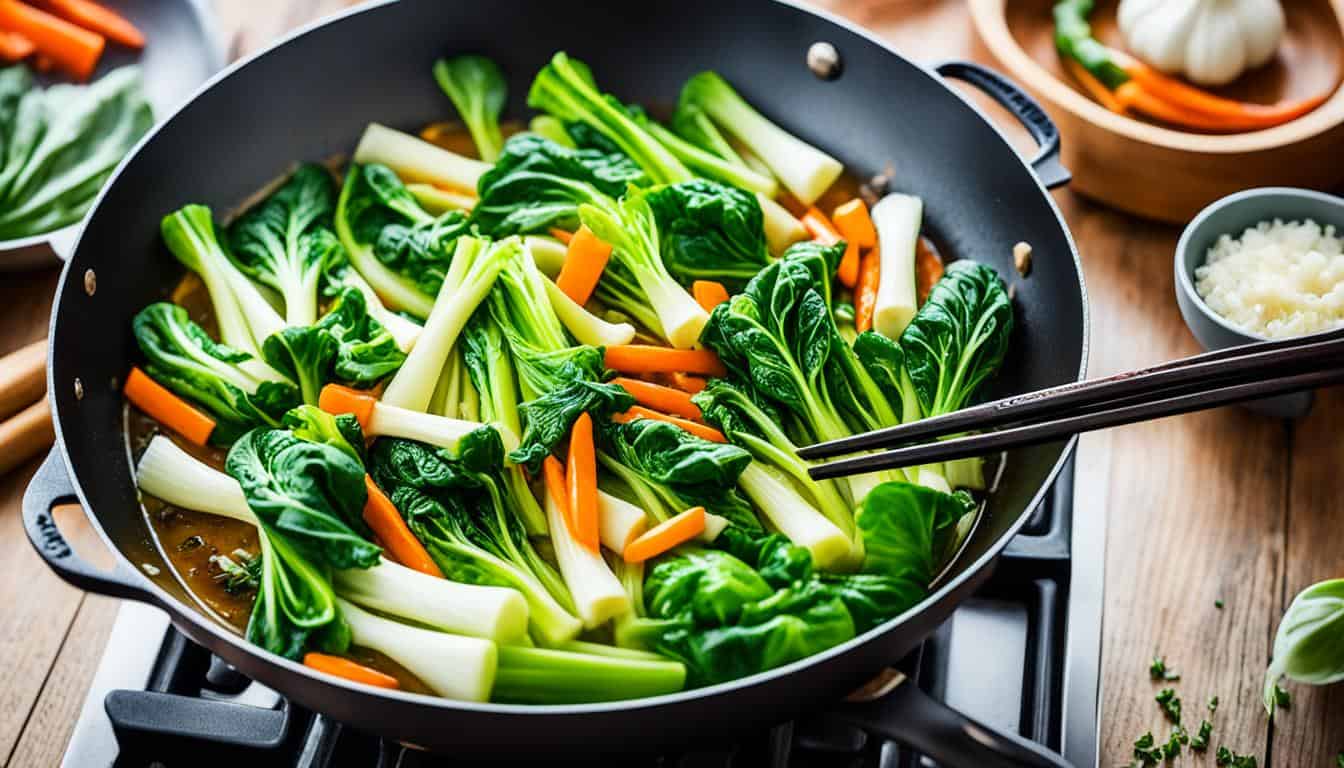
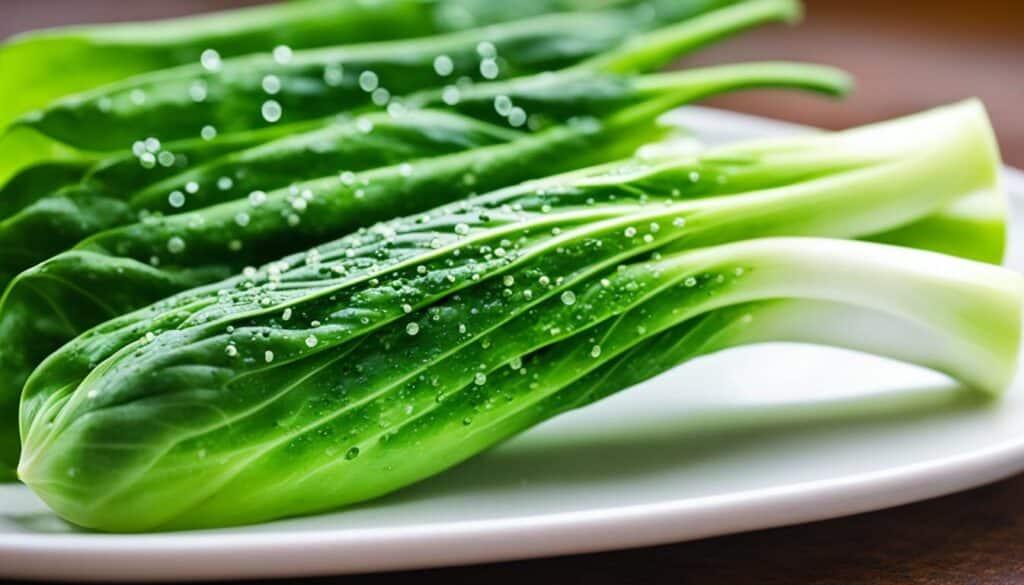
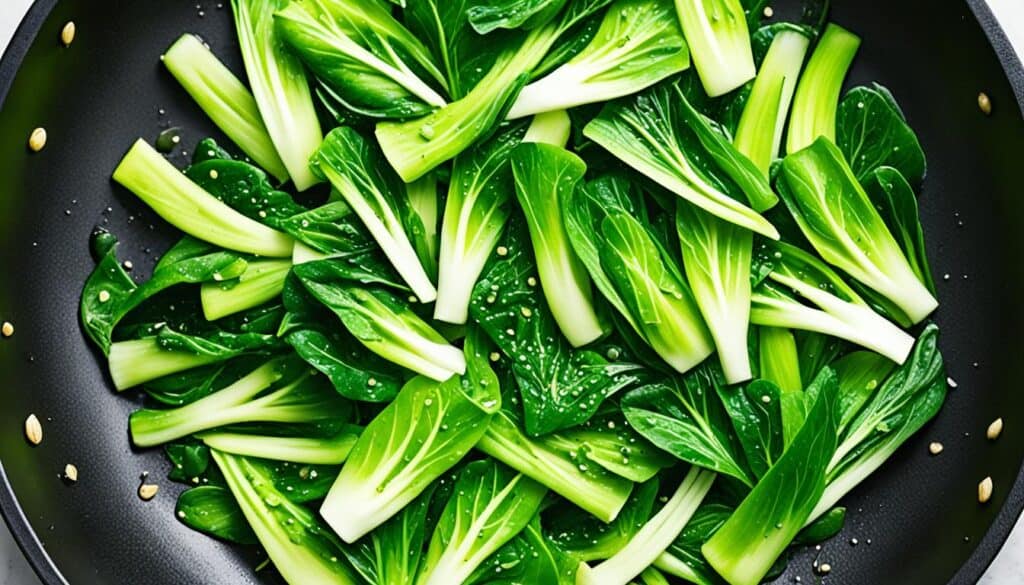
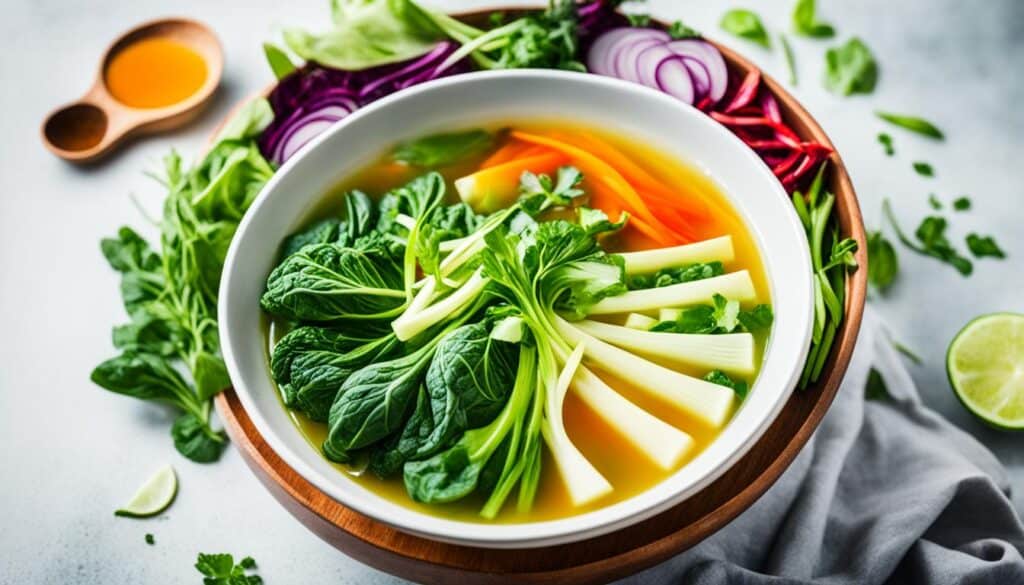
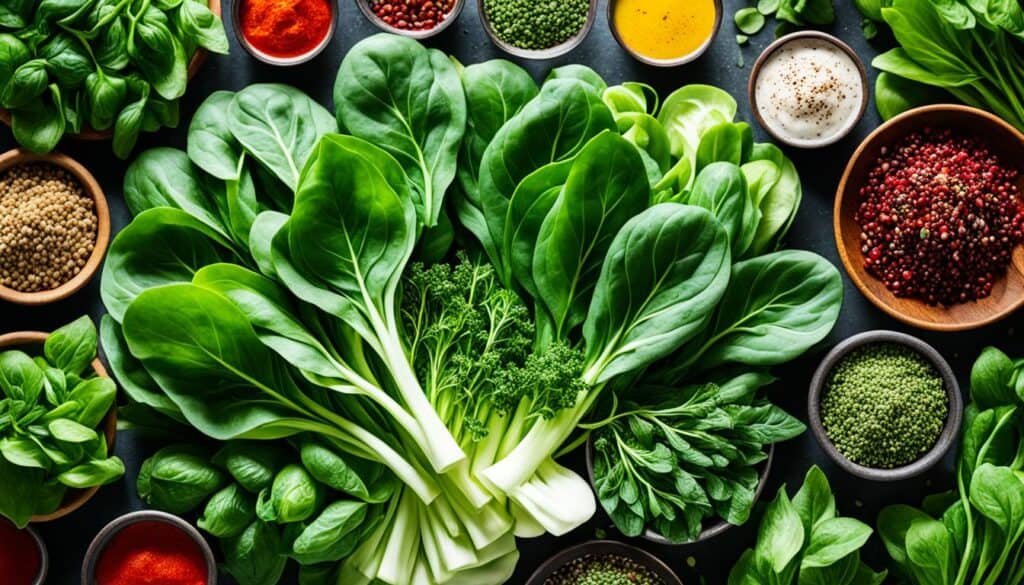
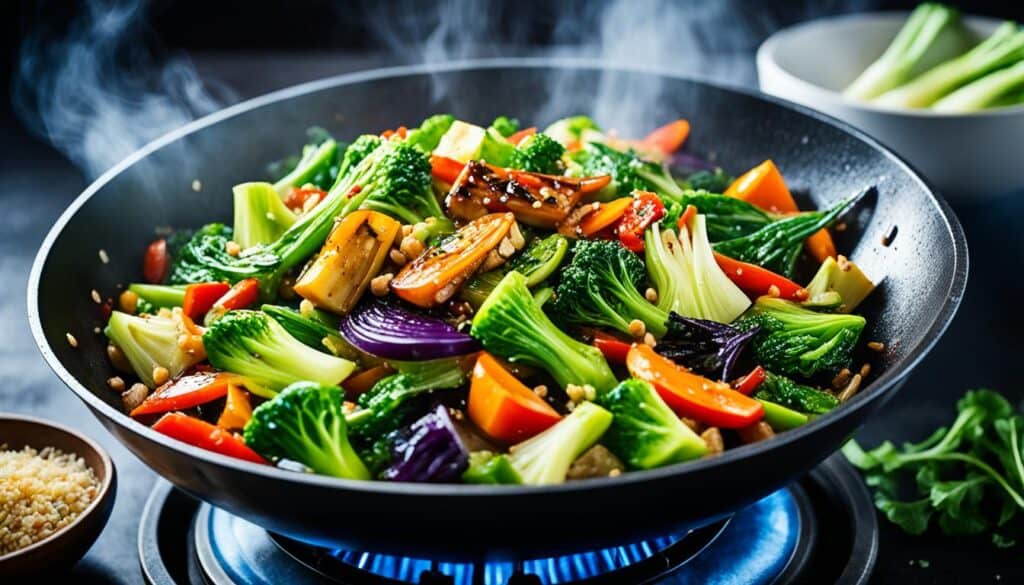



Leave a Reply